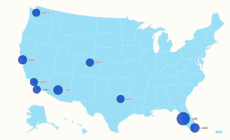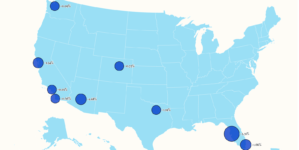-
Man Finds 3-Week-Old Kitten on Construction Site, Knows What to Do Next - 14 mins ago
-
Police investigating death of ‘full-term infant’ found near USC campus - 36 mins ago
-
Whole Foods, MAHA and the Battle Over Healthy Eating in America - 38 mins ago
-
Map Reveals Major Metros Suffering Sharpest Declines in Home Values - 49 mins ago
-
In controversial move, LADWP says it will shift its largest gas power plant to hydrogen - about 1 hour ago
-
Israeli Strikes in Gaza Kill at Least 100, Local Health Officials Say - about 1 hour ago
-
Vladimir Guerrero Jr. Makes Blue Jays History in Win over Dodgers - about 1 hour ago
-
Plan to kill 450,000 owls creates odd political bedfellows — loggers and environmentalists - 2 hours ago
-
Alex Cooper’s Call Her Daddy Updates: Andy Cohen Asks Lisa Vanderpump Who to Cut From Housewives - 2 hours ago
-
Money to Help Nations Cope With Climate Disasters Is Declining, U.N. Says - 2 hours ago
Beaver Moon 2025: How To Best See November’s Supermoon
The largest full moon of the year—the “Beaver Moon”—is set to grace the skies on Wednesday November 5, appearing both bigger and brighter than a normal full moon.
The display will be what is known as a “supermoon”, a phenomena which occurs when the the full moon appears near or at the time when the moon’s orbit brings it closest to Earth, at the so-called “perigee.”
The Beaver Moon is set to reach peak illumination at 8:19 a.m. EST on November 5—although it will be below the horizon for U.S. viewers at this time, meaning there will be better times around this to catch the spectacle.
November’s full moon is thought by some to have been given its nickname from how it appears at the same time that Native Americans and trappers traditionally set beaver traps to make fur from the animals’ pelts, while others associate it with beavers building their dams, or similar general preperation ahead of he coming winter.

Where To See the Beaver Moon
This year’s Beaver Moon is expected to be below the horizon during its peak in the morning of November 5, so the evenings of Tuesday November 4 and Wednesday November 5 will likely be the best time to catch it.
On November 4, sunset in New York will be around 4:48 p.m. and moonrise will be around 4 p.m., while in LA sunset will be around 4:57pm and moonrise will be 4:14pm.
On November 5, sunset in New York will be around 4:47 p.m. and moonrise will be 4:35 p.m., while in LA sunset will be 4:56 p.m. and moonrise will be 4:55 p.m.
The supermoon may appear more orange around these times—appropriately enough for fall—and the so-called ‘moon illusion’ could make it appear bigger than it really is.
This phenomena is an optical illusion of sorts that occurs as the result of the brain comparing the moon to the size of trees and buildings seen in the same view of the sky.
When the Beaver Moon rises even higher up, the size may not seem as vast, but it will still be worth catching.
When Is the Next Full Moon?
The next full moon after the Beaver Moon is the—appropriately named—Cold Moon, which will grace the skies on Thursday December 4.
Also called the “Long Night Moon,” this will be the last full moon of the year, with 2026’s first to be the “Wolf Moon”, which will be visible on January 3.
Do you have a tip on a science story that Newsweek should be covering? Do you have a question about supermoons? Let us know via science@newsweek.com.
Source link

















